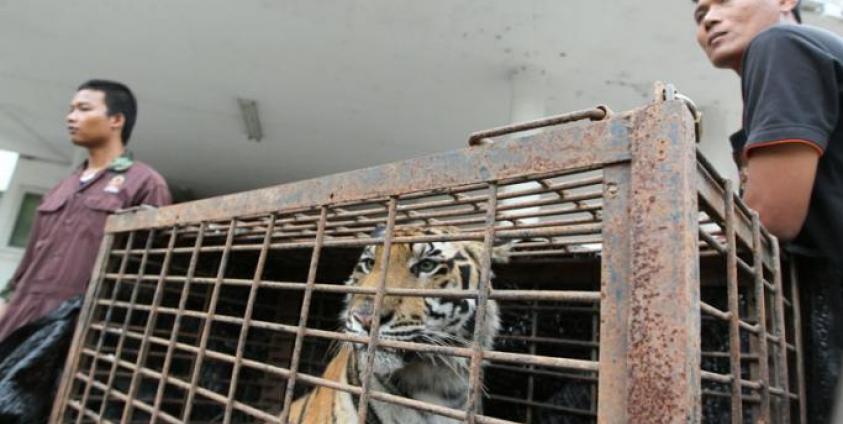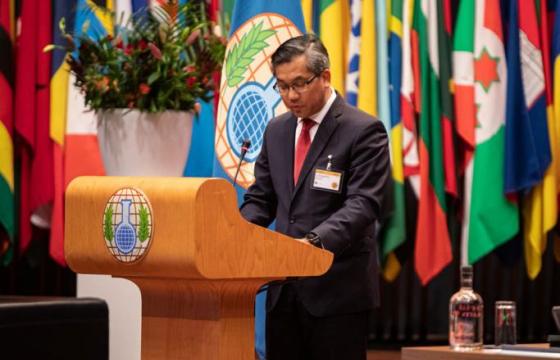China’s deadly illicit trade in wildlife has been thrown into stark relief as Beijing recently announced a temporary ban on the sale of wildlife in the wake of the outbreak of the coronavirus in Wuhan that is suspected to have originated in the city’s wet market.
While the focus is on demand in China for live and dead animals for consumption for questionable health reasons, Myanmar is caught in the cross-hairs as an important transit route in the illicit trade.
The underlying problem is the high demand amongst Chinese consumers for wild animals, from elephant skin to pangolin scales to tiger parts to shark fins.
The result? Many wild animals are under threat from this deadly trade worldwide, some threatened with extinction.
And there is a serious health risk for humans. China’s deadly coronavirus is being linked to animals caged in one of Wuhan’s wet markets though as yet there has been no confirmation.
TEMPORARY TO PERMANENT BAN
With people dropping dead in China from the virus and with a number of cases cropping up abroad, Chinese people and foreign environmentalists have been quick to call for a permanent ban on the sale of wildlife in China.
Conservationists welcomed the news that the Chinese Government had temporarily banned the sale of wildlife in markets, restaurants and over e-commerce as part of an effort to contain the coronavirus outbreak, according to environment magazine Mongabay.
But calls are growing locally and internationally to turn a temporary ban – as happened during the SARS outbreak in 2003 – into a permanent ban.
Just exactly where the virus originated is unclear, with fingers currently pointed at the possibility the virus may have come from a snake or a pangolin sold in a Wuhan wet market. According to the magazine, the zoonotic disease - normally relegated to wildlife - may have originated from a snake and has been traced to a market in the city of Wuhan known for selling wild animals for consumption, including turtles, rats, snakes, hedgehogs and marmots.
“China is to be congratulated for taking such a bold move to ban the wildlife trade and we should encourage China to keep this ban in place permanently,” Steven Galster, founder of the anti-wildlife-trafficking group Freeland, said in a statement. “A sustained ban will save human lives, and contribute to a recovery of wildlife populations worldwide.”
Christian Walzer, chief global veterinarian for the Wildlife Conservation Society, agreed.
The Chinese government’s announcement to temporarily ban the sale of wildlife in markets, restaurants and over e-commerce needs to be permanent, Walzer said in a press release. “The banning of such sales will help end the possibility of future outbreaks of zoonotic diseases, such as the Wuhan coronavirus. We learned this lesson with the outbreak of another zoonotic disease, SARS, in 2002. The pattern will keep repeating itself until we ban, not only in China but in other countries, the sale of wildlife, specifically for food and in food markets.”
THREAT TO HUMAN HEALTH
The illegal trade has far bigger implications in terms of health and the underlying problem of illicit activity, and there is irony in the fact that wildlife killed for its supposed health benefits could be deadly.
David S. Wilcove is a professor of ecology, evolutionary biology, and public affairs at Princeton University says the world wildlife trade threatens both humans and animals alike, given the possibility of zoonotic diseases as suspected in the Wuhan outbreak.
Wilgrove writes in an article in Mongabay entitled “The wildlife trade threatens people and animals alike” that the coronavirus originated in a “seafood” market in the Chinese city of Wuhan that sold much more than fish; Chinese authorities found everything from hedgehogs to wild boars to crocodiles for sale there, providing ideal conditions for viruses to jump to new hosts and, ultimately, to people. HIV can be traced to people killing and butchering chimpanzees for sale in the “bushmeat” trade. And all five of the world’s surviving rhinos face extinction as people hunt them for their horns, which are carved into status trinkets or ground up for their fictitious medicinal value.
He calls for a change in cultural norms in cities around the world, especially in Asia and Africa and the “recognition that keeping wild animals as pets or selling them for products (apart from sustainably caught seafood) is both a threat to the environment and to human health.”
LUCRATIVE TRADE
A study published by Science magazine last year claimed that a quarter of all birds and mammal species are caught up in the international wildlife trade, the demand coming largely from China and some countries in Africa. Thousands of species of animals are under threat, leading to what scientists call “empty forests” syndrome.
Given the strong demand, the trade can be compared in value to that of illegal trafficking of weapons and narcotics.
An international treaty goes some way to addressing the crisis, but not far enough. The Convention on Trade in Endangered Species of Wild Fauna and Flora (CITES) is designed to prevent international trade in endangered species. But it has been found that a quarter of species under threat in the international wildlife trade have yet to be covered by the CITES treaty.
Campaigners warn that CITES is limited to attempting to police trading of animals between nations but not within the nations. And this poses a problem, as seen in the Wuhan virus outbreak, where an infected person could jump on a plane or train and travel to another country, potentially spreading the virus around the world, a process that appears to be underway with the coronavirus.
FALSE BELIEFS
The outbreak of the China virus has helped focus attention on the questionable trade in wildlife to satisfy Chinese demand and the routes, including Myanmar, through which live animals and animal parts are traded and transported.
China is the world’s largest market for wildlife products. The bottom line is the challenge of trying to damp down demand for live and dead species of wildlife in a country of 1.3 billion where the ability to afford some of the more costly and threatened species has grown with the economy and an expanding middle class.
And the problem is bigger than China itself – there remains an appetite for wildlife products in Southeast Asia and many other parts of the world where the products are eaten or consumed as a “health product” or in some cases in the mistaken belief, it is an aphrodisiac.
But this has shocking implications. Consumption of several rare and endangered species, for example, pangolins, rhinos, and elephants, are considered among the biggest threats to their survival in the wild.
And it may threaten people’s lives if the trade leads to the spread of a potentially deadly virus.
MYANMAR'S ROLE
Myanmar is an important trade and transit route for these products, apart from suffering from the loss of its own wildlife to the trade. The capture and killing of wild animals in the country to help satisfy the appetite across the border in China threaten many species that are under threat or facing extinction, including pangolins and elephants.
The situation for Asian elephants living in Myanmar has worsened. According to the NGO Rainforest Rescue, until recently only male Asian elephants were in danger of being poached for ivory, as the females do not have tusks. Now, the poachers are killing every animal they can find – including females and calves. After the elephants slowly succumb to poisoned arrows, the poachers skin their prey on the spot.
The NGO claims the survival of the species is at stake if the killing continues. More than 100 elephants are known to have been poached in Myanmar since 2013 to meet Chinese demand for elephant skin – a market that didn't exist six years ago that is driven entirely by the criminal energy of southeast Asian elephant poachers.
According to a new study, the business is spreading to other countries via Myanmar and China. A major hub of the elephant-skin trade is the lawless Myanmar border town Mong La. It is also flourishing at a market near the Golden Rock, one of Myanmar’s most important Buddhist pilgrimage sites.
The elephant skin is dried, powdered and mixed with coconut oil to make an ointment that is touted as a cure for skin conditions and digestive problems. Traffickers also mix powdered elephant skin and pangolin scales. The skin is also made into jewellery, such as beaded bracelets selling for less than $100.
Rainforest Rescue claims the criminal business is internationally organized and the local authorities turn a blind eye. In Myanmar, elephant poachers face up to seven years in prison, but it has been found that violations are rarely prosecuted. Many animals or animal parts can be found openly being sold in markets in the country.
CHINESE FAILURE
Although the Chinese government has taken some steps to tackle the trade that is decimating wildlife around the world due to mistaken beliefs of the health benefits of consuming the animals or parts of the animals, an effective public awareness appears to be missing, bar the efforts of Chinese basketball star Yao Ming saying “no” to shark fin soup and rhino horn or small Chinese NGOs trying to spread the message.
China’s policymakers have acknowledged that their country plays a pivotal role in elephant poaching. China has banned the ivory trade and is closing its domestic ivory market, but that is not stopping Chinese citizens from crossing the open border to Myanmar and buying elephant products there.
And there is a lively trade in Myanmar in a range of other live and dead wildlife, including the pangolin, the latter possibly linked to the Wuhan virus outbreak.
Last year, on the occasion of World Wildlife Day on 3 March 2019, the Heads of Mission of the European Union (EU) and its Member States congratulated the Myanmar government for the “reinforced initiatives” taken to protect the country's endangered wildlife and biodiversity.
The Myanmar authorities have been waking up to the problem. In May 2018, the Union Parliament passed the Biodiversity and Protected Areas Law, which is one of the strongest wildlife protection laws in the region. On World Wildlife Day, the Myanmar government publicly destroyed seized ivory and wildlife part, part of a series of events to destroy all stockpiles. The Yangon Regional Government has banned all illegal sales of wildlife in Yangon Region as of October 2018, and the government has committed to rolling this ban out nationwide. The Government has also increased public awareness campaigns and engagement on illegal wildlife trade issues through public campaigns, building on the Voices for Wildlife coalition, which is supported by several EU Member States. In October 2018, the UK hosted the London Conference on Illegal Wildlife Trade where the Myanmar government detailed its achievements.
Yet Myanmar continues to face challenges in cracking down on the illegal trade, a trade often boldly displayed in the open in markets across the country, particularly in the ethnic states.
NATIONWIDE BAN?
As the EU stressed last year, while the steps taken are commendable, many species remain under threat and the Myanmar government should fast-track the nationwide ban on the illegal sale of wildlife parts, including in Myanmar’s border areas.
For example, elephant poaching for ivory and other parts is still a huge issue both globally and in Myanmar. Although the elephant skinning crisis in Myanmar has reduced, thanks, in part, to increased wildlife ranger patrols, Myanmar is still facing a struggle to protect its wild elephant population, and the populations of some of its other endangered species, such as the pangolin, tiger and turtles.
According to the advice of the EU, other actions, such as effective enforcement of the ban on wildlife sales and tackling the illicit financial flows from illegal wildlife trade would reinforce the message that Myanmar has a zero-tolerance approach to wildlife crime. As long as criminals continue to sell illegal wildlife products to satisfy consumer demand in China and elsewhere, Myanmar’s wildlife is at risk, and this trade will continue to fill the pockets of criminal gangs and rob Myanmar of its beautiful and diverse wildlife.
LIFE AND DEATH
The Myanmar public has increasingly been brought into the discussion in part because of the campaigns run by NGOs to highlight the threats to the country’s biodiversity.
As the World Wildlife Fund (WWF) Myanmar chapter noted, their Voices for Momos campaign sparked a public conversation about illegal wildlife trade in Myanmar and opened the path to the change needed to protect Myanmar's invaluable wildlife. “We worked with the Government to pass stronger legislation to protect wildlife, and with Yangon region to close down high-profile wildlife markets. We started this campaign to address Myanmar's elephant poaching and skinning crisis - before expanding to all wildlife trade in various regions of the country.”
NGOs such as the WWF have been vocal in their calls to tackle the illicit trade. But there needs to be a commitment on behalf of the Myanmar government, states and regions, and a public more aware of the issues concerning the threat to wildlife but also the potential dangers posed to health, as seen in the coronavirus and SARS – both coming out of China.
Myanmar’s wildlife is being decimated and there needs to be a recognition that this is a “life-and-death” issue – for wildlife and humans alike.






